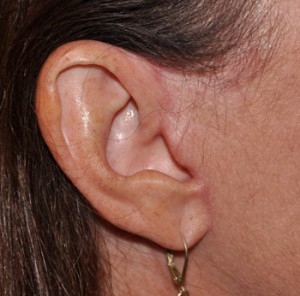One of the most common facial aging problems is the development of jowls and a sagging neck. While a facelift is the most effective treatment, early aging changes do not justify the traditional approach. As a result, facelift surgery techniques have advanced in the past decade to limit the extent of incision and scarring that occur with the traditional methods of facelifting which I will refer to as a full facelift.


The incisions for a mini-facelift starts at the top of ear, goes inside it behind the tragus (bump of cartilage in front of the ear), and then tucks around the earlobe. It stops in the back crease of the ear just above the earlobe. This incision pattern (and ultimately the scars) prevents loss of the location of the sideburn hair and eliminates visible scarring behind the ears. This allows one to wear their hair any way they want without being ‘discovered’.
While less scarring is appealing to any operation, these mini-facelifts are not for everyone. The vast majority of patients that benefit by them are younger by facial again standards, usually being between 40 and 55 years of age. As many people seek neck and jowl improvement at younger ages than ever before, a mini-facelift may be a good procedure to stem the visible signs of jawline and neck aging. These short scar procedures are designed to smooth out the jawline, soften the nasolabial folds and restore a more sinuous and curved facial shape. As one ages, sagging of facial skin and jowls create a more square or ‘bulldog’ look for some. A mini facelift reverses this facial shape change into a more triangular shape which is more synonyous with youth.
The one disadvantage to a shorter scar facelift is it is not as good as improving the significantly droopy neck as that of a traditional lift. This is why older patients with more advanced neck problems have to accept the trade-off of greater scars from more extensive facelifts.
Many mini-facelifts are done with other facial aging procedures as well to get the maximal benefit. When potentially combined with such procedures as liposuction of neck fat, removal of excess eyelid skin and chemical or laser skin resurfacing, that tired aging look can be completely wiped away in a few short hours.
Dr. Barry Eppley
Indianapolis, Indiana


